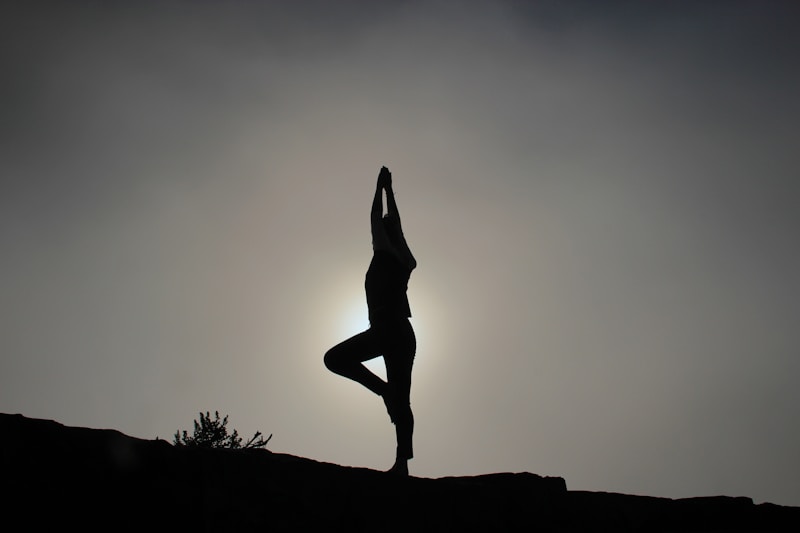Until about five years ago I lived in Denver, Colorado, a state pretty much in the middle of the USA known for its beautiful landscape and the Rocky Mountain range. Most people I knew there were into the outdoors and being active, whether it was hiking, cycling, or skiing. When I first moved to Colorado I was seventeen, physically weak and skinny as a teenager. My posture was not in good condition which was noticeable on my six foot tall body. I didn’t have much control over my arms and legs. More than anything, I was overwhelmed by the amount of exercise everybody in that city did.
From Endurance Training to Yoga
Through college, I slowly started to open up to the new environment and, with time, I joined the movement of being fit and active. A few years later I learned to snowboard, and started running or cycling steep hills. After several years of dedicating time to these activities, I found myself entering into cycling races and triathlons. The training for these events was tough, but the actual races were fun! I was encouraged by supportive friends to participate, and always said “yes” when somebody suggested another challenge. I was never the fastest, but more of a mid-range OK type of a racer. My goal was always to finish and have fun while doing the race.
The hardcore training I did during these years ultimately led me into yoga, as I needed to stretch and to ground myself in order to continue. I was starting to get aches and pains in my hip and lower back from over-training. My IT band (a band of strong connective tissue on top of the muscle that goes from the knee to the hip on the outside of the leg) was screaming with pain after each training session. While I was still getting endorphins from training, physically my body was not feeling great.
Eureka: The Core!
I ended up needing professional help and saw a number of body workers: physiotherapists, chiropractors, osteopathy practitioners, and massage therapists. One of them, a lovely bodyworker called Claire who I met while training for the London Triathlon, recommended I incorporate core exercises into my daily schedule.
She emphasised how a slow build-up is best, and it must be done daily for it to work. By that time I had tried a lot of things from manual adjustments at a chiropractor’s office to rolling on a foam roll at home. Of course she wasn’t the first one to mention core strength to me, I had heard that core work was important, and had even done a few crunches now and then, but didn’t really see the benefit of it come through at that time yet. I promised myself to give it a go.
The results didn’t come over night. It took almost a year for me to really notice the difference. I worked on it diligently, sometimes even doing my five minute core routine twice a day if I got the chance. Sure enough, I slowly started to feel stronger. I started to be able to do things I couldn’t do before: run at a faster pace for longer, keep my spine long while running, go deeper into my yoga stretches and poses, and I even started to find my balance when practising Headstand!
What Does the Core Do Anyway?
The core muscles connect the upper and lower parts of the body. Its main functions are to stabilise the body movement and to protect the spine and internal organs. The core helps us find balance not only in yoga postures, but in everyday movement such as walking to a store, riding a bicycle, or leaning over to pick something up. Any movement of the body is supported by the core.
In addition, the core supports lower back, making sure that the vertebrae have space and are stuck one on top of another symmetrically. Back pain often happens when the vertebrae get squeezed and pushed out of balance. This is why core exercises are often prescribed, to strengthen the muscles that connect to the spine and help the stability of the vertebrae.
Why Don’t I Have A Six-Pack?
When you think about core strength, do you think about a six-pack? A lot of people do. I used to be one of them, thinking that having a strong core means having a nice grill-like muscle definition on stomach that can be shown off while wearing a bikini by the pool or on the beach.
Anatomy tells us differently. The six-pack definition mainly comes from the strength of a muscle called the rectus abdominis. It is only one of a group of muscles that make up the core. This muscle looks good, but its impact on coordination of movement and balance is minimal. The real hard workers of the core are the iliopsoas, transversus abdominis, and the internal/external obliques. These are the deep muscles that are not visible easily, and can be difficult to exercise. However, strength and flexibility in these neglected core muscles helps the body gain more stability, smoother movement and balance and even helps generate energy and stamina. They are the hard workers that help us into Crow Pose. So next time you work on your core, remember the six-pack is only skin deep!
My personal favourite core muscle is the iliopsoas, a complex of the iliacus and psoas muscles. It is a delicate muscle that connects to the vertebrae in the mid to lower spine, and runs through the internal organs to connect at the top of the femur. In addition to helping us lift a leg when walking, or supporting the lower back, this muscle has a number of other functions that one might not expect.
In Eastern Medicine the iliopsoas is known to be connected to emotional responses such as the fight-or-flight instinct. It is said that when this muscle functions normally (ie: strong and flexible) it helps with emotional stability and moving forward through life’s obstacles. This physical and emotional connection can be exercised in two ways: work on developing emotional stability will lead to physical pliability of the iliopsoas, or physically training the iliopsoas will lead to emotional stability
Yoga Poses for the Core
- Crescent Lunge – Hold for ten breaths.
This pose is great for opening up and stretching the iliopsoas. To ensure you engage this delicate muscle in Crescent Lunge, make sure that the hips are squared, and point the tailbone towards the front heel. You can either drop the back knee down to the mat, or keep it up. - Hip Lifts with Bent Knees – Start with ten lifts and gradually work your way up to twenty.
When done correctly, the knees remain directly above the hips, with an exhale the hips lift up slightly to bring the knees higher. This exercise is great for lower and deep lying muscles of the core, such as the transverse abdominis. The slower you lift the knees, the more benefit you will see in the core. - Bicycle Crunches – Ten rounds of reaching to the right and the left knee.
This is the exercise my mom used to do when I was a little girl, it’s timeless! This exercise is still considered by many to be the best exercise for the internal and external obliques. Reach the chest towards one shoulder at a time as you keep the head heavy in the hands locked behind the head. - Plank Pose – Hold for thirty seconds (set a timer or use a metronome and count to thirty).
Another classic, known for getting the whole core engaged. It also works, shoulders, hips, and legs! You can add variety by playing with Forearm Plank or Side Plank. Gradually you will be able to work your way up to one minute. When in plank make sure the heels reach towards the back wall, and the sternum, the breastbone, is facing forward - High Cobra – Hold for three to five deep breaths.
This pose helps to stretch out the core. Some people like to finish their strength work with this stretch, but I prefer to mix it in between different exercises. This allows the muscle to develop pliability by going from strength to stretch.
Get Ready Or Stay Ready?
I still work on my core. I’ve learned it’s easier to maintain than to build up. I no longer need to do my specific core exercise every day; however the right muscles get engaged during my daily yoga practice. In order to get the core to work in the beginning I had to work hard and practice core specific exercise on a daily basis. Once the muscles became engaged and no longer dormant, I was able to control and get them involved much easier.
Would you like to have a strong core that you can use in yoga and everyday life? What would you be willing to give to have it? Could it be worse five minutes a day? Can you imagine what it would feel like to be free of everyday back pain? Comment below to tell me about your experience with core strength. Let me know if you did some core exercises today, or plan to do it tomorrow!












